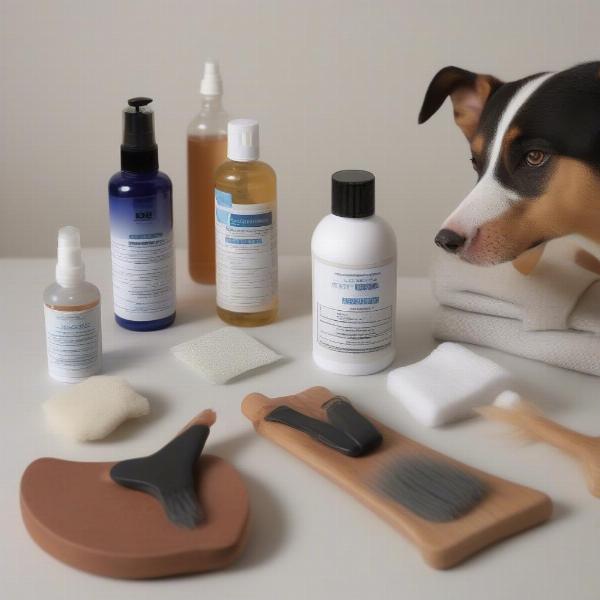Ear wax is a natural substance that helps protect your dog’s ears from dirt, debris, and bacteria. However, excessive ear wax can lead to discomfort, infections, and even hearing loss. Choosing the right ear wax remover for your dog is crucial for their overall ear health. This guide will delve into everything you need to know about ear wax removal for dogs, from understanding the causes of excessive wax to choosing the best cleaning solutions and techniques.
Understanding Canine Ear Wax
Just like humans, dogs produce ear wax, also known as cerumen. It’s a yellowish-brown, waxy substance secreted by glands in the ear canal. A healthy amount of ear wax is essential for lubricating the ear canal, trapping dirt and debris, and preventing infections. However, certain breeds, such as Cocker Spaniels and Basset Hounds, are more prone to excessive wax buildup due to their ear structure. Allergies, infections, and mites can also contribute to increased wax production. Ignoring excessive ear wax can lead to several issues, including ear infections, discomfort, head shaking, and even hearing loss.
Choosing the Right Ear Wax Remover for Dogs
Several types of ear wax removers are available for dogs, each with its pros and cons. It’s vital to choose a product specifically formulated for dogs to avoid irritation or damage to their sensitive ears.
Types of Ear Cleaners
- Ceruminolytic Ear Cleaners: These solutions contain ingredients that break down ear wax, making it easier to remove. They are often recommended for dogs with excessive wax buildup.
- Drying Ear Cleaners: These cleaners help dry out the ear canal, which can be beneficial for dogs prone to ear infections.
- Antiseptic Ear Cleaners: These solutions contain ingredients that kill bacteria and fungi, helping to prevent and treat ear infections.
 Different Types of Dog Ear Cleaners on a Table
Different Types of Dog Ear Cleaners on a Table
Ingredients to Look For
Look for ear cleaners containing natural ingredients like aloe vera or chamomile, which can soothe irritated skin. Avoid products with harsh chemicals or alcohol, as these can dry out the ear canal and cause further irritation. Always consult your veterinarian before using any new ear cleaning product, especially if your dog has a history of ear infections or allergies.
How to Clean Your Dog’s Ears
Cleaning your dog’s ears is a relatively simple process, but it’s important to do it correctly to avoid causing your dog any discomfort or injury.
- Gather your supplies: You’ll need a dog-specific ear cleaning solution, cotton balls or gauze pads, and treats to reward your dog.
- Restrain your dog: Gently hold your dog still, or have someone assist you.
- Fill the ear canal: Carefully fill your dog’s ear canal with the cleaning solution, following the instructions on the product label.
- Massage the base of the ear: Gently massage the base of the ear for 30 seconds to help distribute the solution and loosen the wax.
- Allow your dog to shake their head: This will help dislodge the loosened wax and debris.
- Wipe away the excess: Use cotton balls or gauze pads to gently wipe away any remaining solution and debris.
- Reward your dog: Give your dog a treat for their cooperation.
When to See a Vet
While regular ear cleaning can help prevent many ear problems, sometimes a veterinarian’s intervention is necessary. Consult your vet if you notice any of the following:
- Excessive redness or swelling in the ear canal
- Foul odor coming from the ears
- Discharge from the ears
- Signs of pain or discomfort, such as head shaking or pawing at the ears
- Hearing loss
Conclusion
Maintaining your dog’s ear health is crucial for their overall well-being. Choosing the right ear wax remover for dogs and following proper cleaning techniques can prevent many ear problems. Regular cleaning, combined with vigilance and prompt veterinary care when necessary, will ensure your furry friend’s ears stay healthy and happy.
FAQ
- How often should I clean my dog’s ears? The frequency of ear cleaning depends on your dog’s breed and individual needs. Consult your veterinarian for personalized advice.
- Can I use hydrogen peroxide to clean my dog’s ears? It’s generally not recommended to use hydrogen peroxide, as it can irritate the delicate skin of the ear canal.
- What are the signs of an ear infection in dogs? Signs of an ear infection can include redness, swelling, discharge, odor, head shaking, and scratching at the ears.
- Are there any home remedies for dog ear wax removal? While some home remedies exist, it’s always best to consult with a vet before trying any at-home treatments.
- My dog keeps shaking their head. Could it be ear wax? Head shaking can be a sign of ear wax buildup, but it can also be caused by other ear problems, such as infections or allergies.
- What should I do if I accidentally push ear wax deeper into my dog’s ear? If you think you’ve pushed wax deeper into your dog’s ear, stop cleaning and consult your veterinarian.
- Can I use Q-tips to clean my dog’s ears? No, Q-tips should never be used to clean a dog’s ears, as they can push wax further into the canal and potentially damage the eardrum.
Related Articles on ILM Dog
About ILM Dog
ILM Dog (ILM Dog) is your one-stop resource for comprehensive, expert advice on dog care, covering everything from breed selection and health to training, nutrition, and grooming. We offer practical guidance and valuable insights to help dog owners worldwide ensure the well-being of their beloved companions. For expert advice and personalized recommendations, contact us at [email protected] or +44 20-3965-8624.